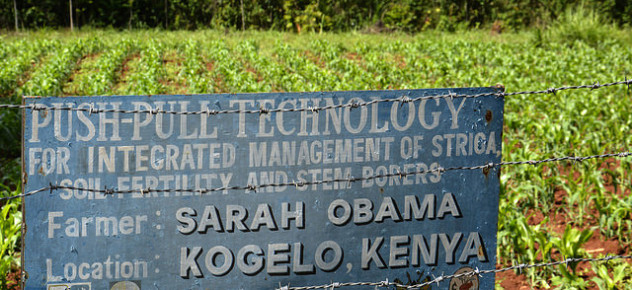Ask any non-African what they usually associate with this continent – at least when a crisis like the current Ebola outbreak isn’t capturing everyone’s attention – and they’re likely to mention Africa’s spectacular big game. But what if someone were to make the case that a far less charismatic slice of Africa’s biological diversity – particularly an un-photogenic forage grass called Brachiaria – also deserves special attention because of its potential to deliver big economic gains for the region while also improving the environment?
The subtle appeal of this tropical grass is unlikely to inspire many documentary films. But it does motivate a group of scientists working in Eastern and Central Africa to promote the plants for improving agriculture and natural resources. The researchers’ goal is to provide farmers with new and more powerful ways to intensify crop and livestock production sustainably.
High population growth and rapid urbanization are boosting the demand for food, which is supplied mostly by so-called “mixed” farming systems. Combining crops and animals, these systems provide livelihoods for a majority of the region’s rural population. But mixed farming has many problems, which prevent it from keeping pace with burgeoning food demand. The production of milk and meat in particular are constrained by a lack of good quality animal feed.
Much research has shown that various tropical grasses and legumes can help overcome the feed shortage, enhancing livestock nutrition and raising farm incomes, while also improving soil fertility and reducing erosion. Yet, for many years, progress in exploiting the potential of forage plants was slow. More recent work – focused on Bracharia grasses that originated in Africa but were then improved in Latin America – has set the stage for integrating these and other superior tropical forages into mixed farming systems on a large scale.
.@AgroBioDiverse More on Brachiaria from the @BecAHub blog: ‘Africa’s super grass’ http://t.co/G0OJvh7996
— Susan MacMillan (@SusanMacMillan) October 30, 2014
CIAT forage scientist Brigitte Maass, together with eight other scientists in the region, recently prepared an overview of encouraging progress with the introduction of high-performing Brachiaria grasses in a dozen African countries. Of all the efforts they describe, the most successful was prompted less by Brachiaria’s well-known value as livestock feed and more by another important role for the grass that CIAT scientists never imagined.
A few years ago, entomologists at the International Centre for Insect Physiology and Ecology (icipe), with headquarters in Nairobi, Kenya, determined that Brachiaria serves quite well as a “trap” crop, attracting and aiding the destruction of stem borer, a devastating insect pest of maize and other cereals. For this purpose, scientists incorporated the grass into a novel crop production technology called “push-pull.”

A technology demonstration plot belonging to “Mama” Sarah Obama, step-grandmother of Barack Obama, president of the USA. Credit: Nathan Russell / CIAT
It’s the brainchild of icipe entomologist Zeyaur Khan, who has meticulously refined and tirelessly promoted the practice since he and his partners first developed it during the mid-1990s. Brachiaria’s drought tolerance has made the latest version of push-pull “climate smart,” permitting its extension into drier areas.
Superficially, all is order and symmetry in the push-pull system. Small plots of maize or sorghum are bordered on all sides with a few rows of Brachiaria grass. Farmers sow a forage legume, Greenleaf Desmodium, between the rows of cereals. But behind the scenes, things get rough. Desmodium destroys the parasitic weed Striga, another major pest of cereals, while also giving stem borers a push through volatile chemicals that repel the insect pest. Meanwhile, Brachiaria gives stem borers a pull, chemically enticing them to come and lay their eggs, while simultaneously calling in natural enemies to destroy the pests.
Around 30,000 farmers have adopted Brachiaria with the climate-smart push-pull method in 4 African countries http://t.co/38TdLg0JtJ
— CIAT (@CIAT_) October 29, 2014
More than 30,000 smallholder farmers in Kenya, Ethiopia, Tanzania, and Uganda have taken up the climate-smart version of push-pull. They’re highly pleased with the dramatic boost in milk yields that results from feeding cattle with Brachiaria and also about the disappearance of stem borers and Striga.
This latter point is what first got the attention of “Mama” Sarah Obama, the step-grandmother of US president Barack Obama. She lives at K’ogelo village in Siaya District, the ancestral homeland of the president’s father. In a conversation with Zeyaur Khan several years ago, Mama Sarah shared her concern about Striga, which she warned “is destroying the livelihoods of the Luo people.” After Khan explained how push-pull drives out Striga, she decided to introduce the approach in a half-hectare maize field at the entrance of her compound, which receives literally busloads of visitors every week. With its pale blue metal sign identifying the push-pull plot as Mama Sarah’s, this must be the most frequently visited agricultural demonstration plot in Kenya, if not all of Africa.